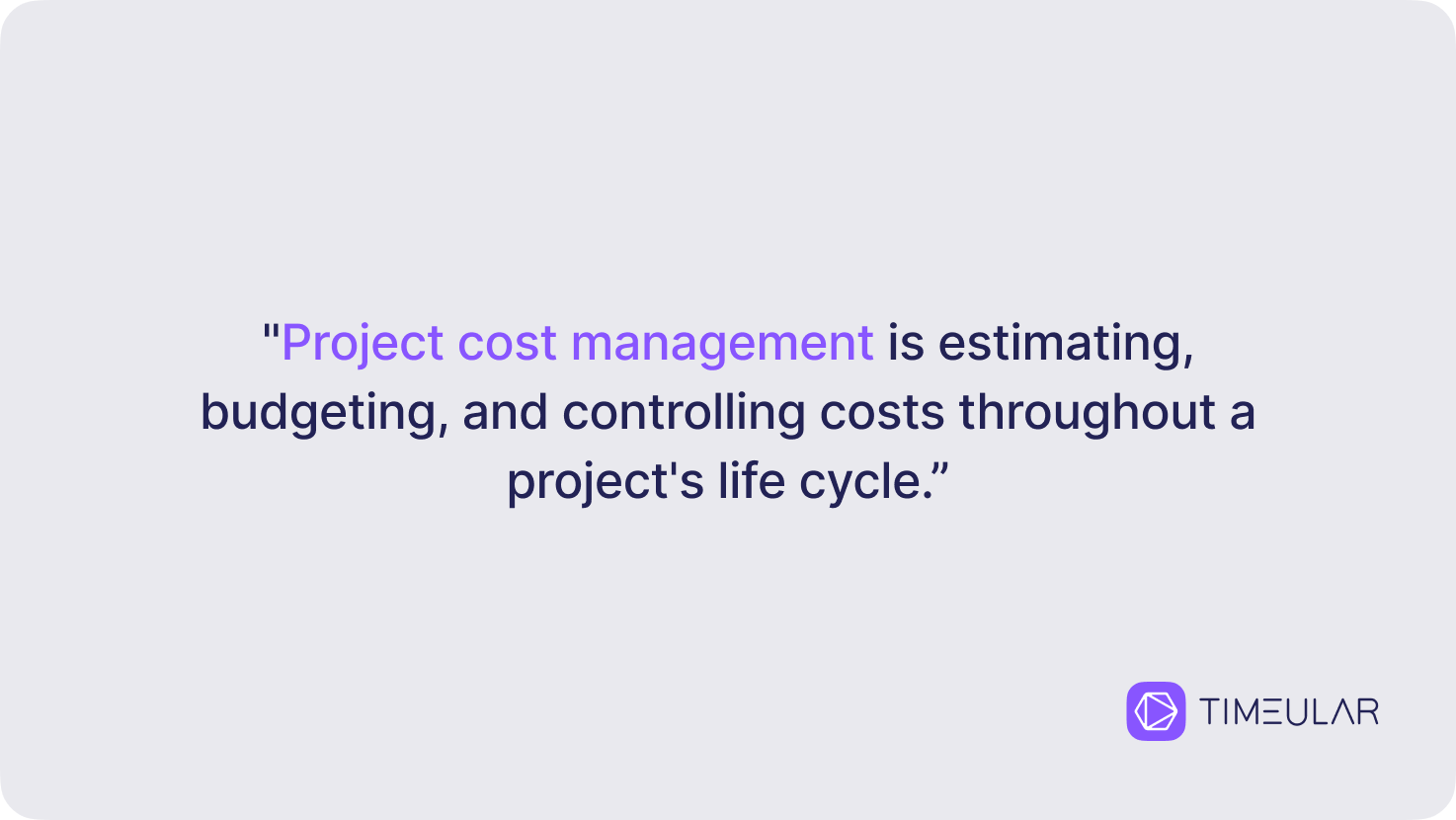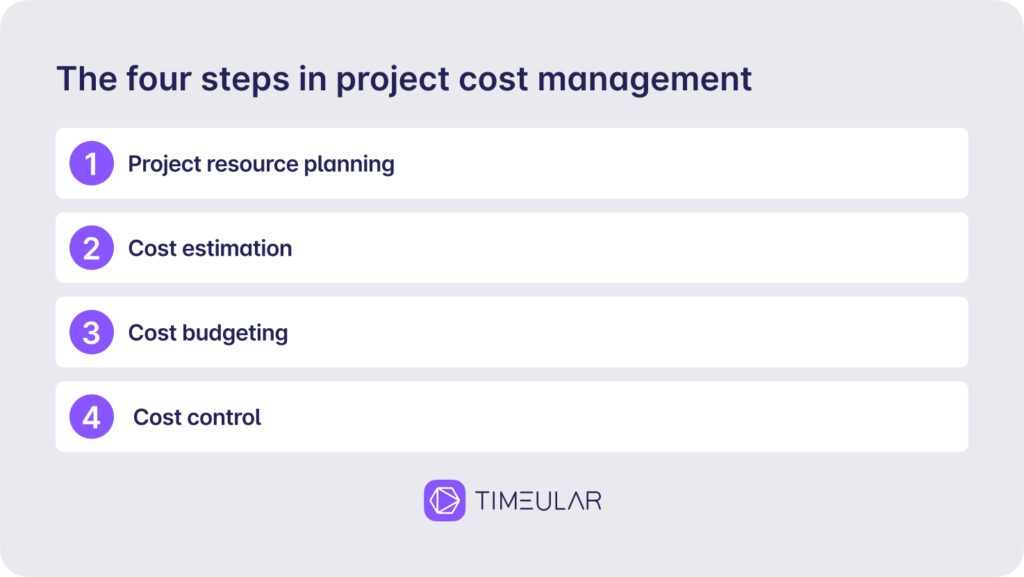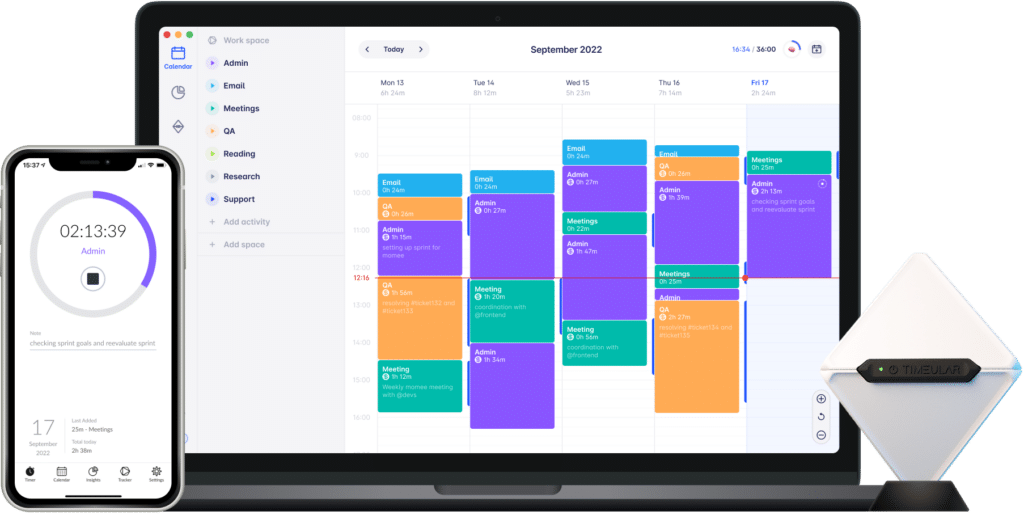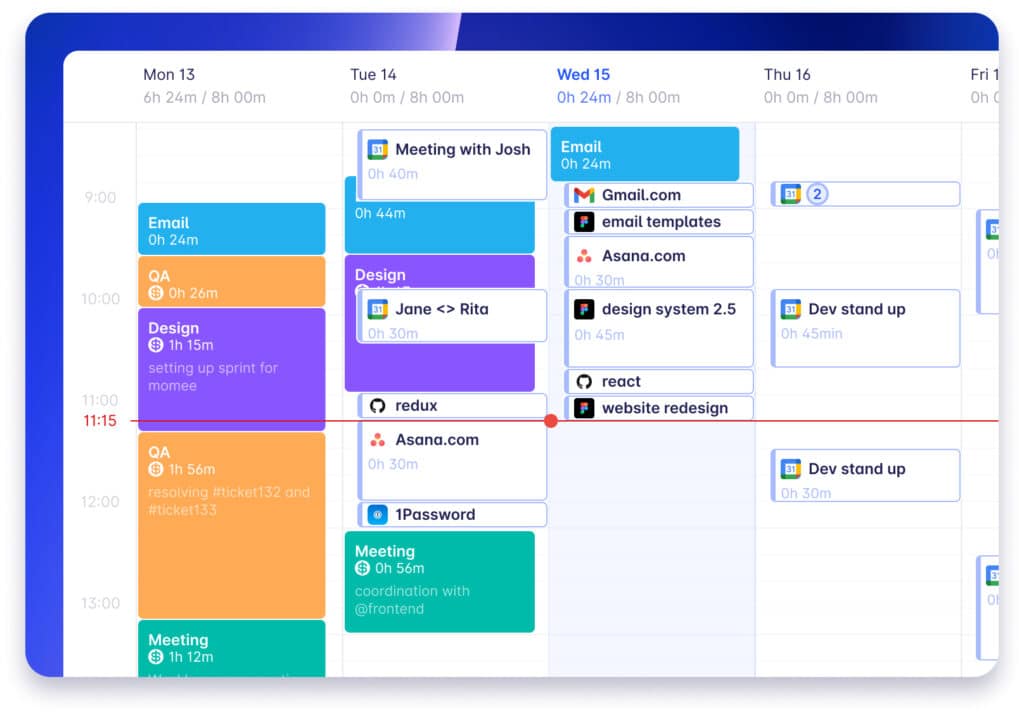Projektkostenmanagement: Der ultimative Leitfaden
Stellen Sie sich Folgendes vor: Sie sind Projektmanager und haben die Aufgabe, eine bahnbrechende Initiative durchzuführen. Es steht viel auf dem Spiel, und der Druck ist groß. Sie wissen, dass der Erfolg Ihres Projekts nicht nur von der Kompetenz Ihres Teams abhängt, sondern auch von Ihrer Fähigkeit, die Komplexität des Projektkostenmanagements zu bewältigen .
Da das Projektkostenmanagement eine vielschichtige Disziplin ist, habe ich recherchiert, um dir die Arbeit zu erleichtern.
Daher findest du in diesem umfassenden Leitfaden:
- Das Konzept des Projektkostenmanagements und seine Bedeutung;
- Verschiedene Techniken und wichtige Instrumente für das Projektkostenmanagement;
- Gemeinsame Herausforderungen für die Teams.
Am Ende dieses Artikels sind Sie für die Anforderungen des Projektkostenmanagements gerüstet und haben ein gutes Verständnis für verschiedene Techniken, Werkzeuge und bewährte Verfahren.

Was ist Projektkostenmanagement?
Das Projektkostenmanagement umfasst die Schätzung, Budgetierung und Kontrolle der Kosten während des gesamten Lebenszyklus eines Projekts. Sein Hauptziel ist es, sicherzustellen, dass die Ausgaben im Rahmen des genehmigten Budgets bleiben.
Damit ein Projekt als erfolgreich angesehen werden kann, muss es die folgenden Kriterien erfüllen:
- Erfüllung der festgelegten Anforderungen und des Umfangs.
- Erzielung eines hohen Qualitätsstandards bei der Ausführung.
- Fertigstellung innerhalb des vereinbarten Zeitplans.
- Einhalten des zugewiesenen Budgets.
Daher ist das Projektkostenmanagement eine der grundlegenden Säulen des Projektmanagements, die in verschiedenen Branchen wie der Fertigung, dem Einzelhandel, der Technologie, dem Bauwesen und vielen anderen anwendbar ist.
Sie spielt eine wichtige Rolle bei der Erstellung einer finanziellen Ausgangsbasis, anhand derer die Projektmanager den Status ihrer Projektkosten bewerten und gegebenenfalls Anpassungen vornehmen können.

Warum ist das Projektkostenmanagement wichtig?
Ein effizientes Projektkostenmanagement ermöglicht es Projektmanagern,:
- Setzen Sie klare Erwartungen an die Beteiligten.
- Beherrschen Sie die schleichende Ausweitung des Projektumfangs, indem Sie für Transparenz gegenüber dem Kunden sorgen.
- Überwachung der Fortschritte und unverzügliche Umsetzung von Korrekturmaßnahmen.
- Halten Sie die erwarteten Gewinnspannen ein, erhöhen Sie den ROI und verhindern Sie finanzielle Verluste bei dem Projekt.
- Generierung von Daten für künftiges Projekt-Benchmarking und die langfristige Verfolgung von Kostentrends.
Die Bedeutung des Kostenmanagements ist einfach zu verstehen. Betrachten wir zur Veranschaulichung das Beispiel des Baus eines Hauses als Teil eines Projektlebenszyklus.
- Der erste Schritt ist die Aufstellung eines Budgets, das einen Überblick über die finanziellen Grenzen des Projekts gibt. Sobald das übergeordnete Budget feststeht, wird es weiter in Ausgaben für Teilaufgaben und kleinere Einzelposten unterteilt.
Das Budget spielt eine entscheidende Rolle bei wichtigen Entscheidungen, z. B. bei der Wahl des richtigen Designers: eines Designers, der das gesamte Projekt von Anfang bis Ende betreuen kann, oder eines Designers, der bei bestimmten Elementen behilflich sein kann, während er mit einem kleineren Budget arbeitet. Außerdem entscheidet das Budget über die Anzahl der Räume in der Struktur und die Qualität der zu verwendenden Materialien.
Ohne ein genau definiertes Budget wird die Beantwortung dieser Fragen schwierig und die Bewertung des Projektfortschritts nahezu unmöglich.
In größeren Organisationen wird diese Herausforderung durch die gleichzeitige Durchführung mehrerer Projekte, Änderungen der ursprünglichen Annahmen und unerwartete Kosten noch verschärft. Genau hier setzt der Prozess des Kostenmanagements an und wird entscheidend.
TIPP: Techniken zur Projektüberwachung und -kontrolle.
Die vier Schritte des Projektkostenmanagements
Das Kostenmanagement ist ein kontinuierlicher Prozess im Projektlebenszyklus, aber eine Unterteilung in vier verschiedene Schritte kann ein besseres Verständnis und eine bessere Ausführung ermöglichen: Ressourcenplanung, Schätzung, Budgetierung und Kontrolle. Obwohl diese vier Schritte in der Regel nacheinander ablaufen, können Anpassungen erforderlich sein, wenn sich die Ressourcen während des Projekts ändern.
Lassen Sie uns die einzelnen Schritte im Detail betrachten:

1. Planung der Projektressourcen
Bei der Ressourcenplanung geht es darum, die für die Durchführung und den erfolgreichen Abschluss eines Projekts erforderlichen Ressourcen zu ermitteln. Zu diesen Ressourcen können Personal (Mitarbeiter und Auftragnehmer) und Ausrüstung (wie Infrastruktur und Spezialmaschinen) gehören.
Diese Planung erfolgt zu Beginn des Projekts , bevor die eigentliche Arbeit beginnt. Die Projektmanager entwickeln einen Projektstrukturplan (PSP), um den Ressourcenbedarf für jede Teilaufgabe zu ermitteln, z. B. die Anzahl der Mitarbeiter mit bestimmten Fähigkeiten und die benötigten Materialien oder Geräte.
Bei der Ressourcenplanung müssen historische Daten, Rückmeldungen von Fachexperten (KMU) und die Auswirkungen zeitlicher Beschränkungen auf die Verfügbarkeit von Ressourcen berücksichtigt werden. Die Gegebenheiten vor Ort können Anpassungen erfordern, z. B. die Beauftragung externer Auftragnehmer oder die Schulung interner Teams.
Lesen Sie auch: Beispiele für Ziele im Projektmanagement
2. Kostenvoranschlag
Bei der Kostenschätzung geht es darum, die mit allen erforderlichen Projektressourcen verbundenen Ausgaben zu quantifizieren. Um die Kosten genau zu berechnen, ist es wichtig:
- Ressourcenbedarf (aus dem Schritt der Ressourcenplanung)
- Preise der einzelnen Ressourcen (z. B. Personalkosten, Lieferantengebühren, Materialpreise)
- Dauer, für die jede Ressource benötigt wird
- Liste der Annahmen und potenziellen Risiken
- Frühere Projektkosten und Benchmarks der Branche
- Einsicht in die finanzielle Lage des Unternehmens
Die Schätzung ist ein kritischer Schritt, da Abweichungen zwischen geschätzten und tatsächlichen Kosten den Projekterfolg beeinträchtigen können.
Es gibt verschiedene Schätzungsmodelle, z. B. die analoge Schätzung, die parametrische Modellierung und die Programmbewertungs- und -überprüfungstechnik (PERT).
Die Entscheidung, ob ein Top-down- oder ein Bottom-up-Ansatz gewählt wird, hängt von den verfügbaren Daten zur Kostenrechnung und den Projekterfahrungen ab.
Die Kostenschätzung hilft auch bei der Entscheidungsfindung in der Planungsphase, indem sie mehrere Projektlösungen vergleicht und Strategien zur Kostensenkung, wie z. B. Value Engineering, bewertet.
3. Kostenbudgetierung
Bei der Budgetierung von Projektkosten werden die Kosten für bestimmte Projektsegmente, wie z. B. einzelne Aufgaben oder Module, über einen bestimmten Zeitraum zugewiesen. Die Budgets können Rücklagen für unvorhergesehene Ausgaben enthalten.
Durch die Budgetierung wird eine Kostenbasis geschaffen, anhand derer die Projektkostenleistung gemessen und bewertet werden kann. Sie ermöglicht die Bewertung des künftigen Finanzierungsbedarfs, so dass der Projektleiter Ziele auf der Grundlage der verfügbaren finanziellen Ressourcen festlegen kann.

Starten Sie die Zeiterfassung mit Timeular. Halten Sie das Budget ein, schätzen Sie die Dauer von Aufgaben genau ab und überwachen Sie die Ressourcenzuweisung!
4. Kostenkontrolle
Die Kostenkontrolle ist ein kontinuierlicher Prozess, bei dem Kostenabweichungen von der Basislinie überwacht und geeignete Maßnahmen zur Behebung von Diskrepanzen eingeleitet werden.
Dieser Schritt erfolgt während des gesamten Lebenszyklus des Projekts und setzt eine rechtzeitige und transparente Projektberichterstattung voraus.
Der Kostenmanagementplan, in dem Messkriterien, Abweichungsschwellen, Korrekturmaßnahmen und Entscheidungsbefugnisse detailliert aufgeführt sind, ist ein wesentlicher Beitrag zur Kostenkontrolle. Das Earned Value Management (EVM) ist ein beliebter Ansatz zur Messung der Kostenleistung.
Durch die Messung des tatsächlichen Fortschritts im Vergleich zum geplanten Fortschritt und die Bewertung von Termin- und Kostenabweichungen verschafft die Kostenkontrolle den Entscheidungsträgern Transparenz und die Möglichkeit, umgehend auf Projektsituationen zu reagieren.
Empfohlen:
- Die besten Möglichkeiten zur Verfolgung von Projektausgaben
- Aufschlag-Rechner
- Überstunden-Rechner
- Zeitkarten-Rechner
- Margen-Rechner

Formeln für die Verwaltung der Projektkosten
Um den finanziellen Zustand eines Projekts zu beurteilen und seine Leistung zu bewerten, stützen sich Projektmanager auf mehrere Schlüsselformeln. Diese Formeln helfen ihnen bei der Messung von Kosteneffizienz, Leistung und Abweichungen. Hier sind einige wichtige Formeln:
Kosten-Leistungs-Index (CPI)
Der CPI gibt den Wert der geleisteten Arbeit pro aufgewendeter Kosteneinheit an.
Ein CPI von mehr als 1 deutet auf eine effiziente Kostenentwicklung hin, was bedeutet, dass das Projekt mehr Wert aus jedem ausgegebenen Dollar zieht. Ein CPI von weniger als 1 deutet dagegen auf Kostenüberschreitungen hin.
Kostenleistungsindex (CPI) = Erreichter Wert (EV) / Tatsächliche Kosten (AC)
Zeitplan-Leistungsindex (SPI)
Der SPI bewertet die Effizienz des Projektzeitplans.
Ein SPI größer als 1 bedeutet, dass der Zeitplan gut eingehalten wird, d. h., das Projekt liegt vor dem Zeitplan. Umgekehrt weist ein SPI von weniger als 1 auf Verzögerungen im Projekt hin.
Zeitplan-Leistungsindex (SPI) = Erreichter Wert (EV) / Geplanter Wert (PV)
Kostenabweichung (CV)
Der Lebenslauf misst die Abweichung zwischen dem Arbeitswert (dem Wert der geleisteten Arbeit) und den tatsächlich angefallenen Kosten.
Ein positiver Lebenslauf bedeutet Kosteneinsparungen, während ein negativer Lebenslauf auf Kostenüberschreitungen hindeutet.
Kostenabweichung (CV) = Erreichter Wert (EV) - Tatsächliche Kosten (AC)
Kostenvoranschlag bei Fertigstellung (EAC)
Die EAC prognostiziert die voraussichtlichen Gesamtkosten des Projekts auf der Grundlage der aktuellen Leistung.
Sie berücksichtigt das Budget bei Fertigstellung und den Kostenleistungsindex, um die Gesamtkosten des Projekts zu schätzen.
Kostenvoranschlag bei Fertigstellung (EAC) = Budget bei Fertigstellung (BAC) / Kostenleistungsindex (CPI)
Techniken des Projektkostenmanagements
Die Einführung wirksamer Kostenmanagementtechniken ist entscheidend für die Kontrolle der Projektkosten und die Gewährleistung des finanziellen Erfolgs. Hier sind einige wesentliche Techniken:
- Bottom-up-Schätzung: Bei dieser Technik wird das Projekt in kleinere, besser überschaubare Aufgaben aufgeteilt und die Kosten für jede Komponente einzeln geschätzt. Die Zusammenfassung dieser Schätzungen ergibt eine genauere Schätzung der Gesamtprojektkosten.
- Analyse der Reserven: Projekte sind von Natur aus anfällig für Unwägbarkeiten und unerwartete Ereignisse. Bei der Reserveanalyse werden Rücklagen gebildet, um potenziellen Risiken Rechnung zu tragen. Diese Reserven dienen als Puffer, um unvorhergesehene Umstände zu bewältigen, ohne das primäre Projektbudget zu beeinträchtigen.
- Parametrische Schätzung: Bei dieser Technik werden historische Daten und statistische Beziehungen zur Kostenschätzung herangezogen. Die Projektmanager verwenden historische Kostendaten aus früheren ähnlichen Projekten und wenden sie auf das aktuelle Projekt an, wobei sie Variablen wie Größe, Komplexität und andere relevante Parameter berücksichtigen.
- Analoge Schätzung: Diese auch als Top-Down-Schätzung bezeichnete Technik stützt sich auf das Urteil von Experten und historische Daten aus früheren Projekten, um die Kosten des aktuellen Projekts zu schätzen. Sie ist besonders in der Anfangsphase eines Projekts nützlich, wenn nur wenige detaillierte Informationen vorliegen.
- Earned Value Management (EVM): EVM ist eine leistungsstarke Technik, die den Projektumfang, den Zeitplan und die Kosten integriert, um die Projektleistung zu bewerten und zukünftige Ergebnisse vorherzusagen. Es ermöglicht Projektmanagern, den Fortschritt objektiv zu messen und Abweichungen vom genehmigten Budget und Zeitplan zu erkennen.

Werkzeuge für das Projektkostenmanagement
Im digitalen Zeitalter sind Projektmanagement-Tools für ein effizientes Kostenmanagement unverzichtbar geworden. Diese Werkzeuge rationalisieren nicht nur die Prozesse, sondern verbessern auch die Genauigkeit und die Zusammenarbeit.
Es gibt verschiedene Projektmanagement-Tools und -Software, die Ihre Leistung und Produktivität als Projektmanager steigern, z. B. Projektmanagement-Kostensoftware, Tools zur Verwaltung des Arbeitsaufwands, Tools zur Ressourcenverwaltung und -planung sowie Tools zur Zeiterfassung:
- Timeular (Zeiterfassung)
- Asana (Projektverwaltung)
- Zoho Projects (Projektverwaltung)
- ClickUp (Projektverwaltung)
- GanttPRO (für Gantt-Diagramme)
- Ressourcen-Guru (Ressourcenplanung)
- Runn (Ressourcenplanung)
Warum und wie hilft die Zeiterfassung bei der Projektverwaltung?
Wenn Sie ein Projektmanager sind, sollten Sie wissen, dass die Zeiterfassung in verschiedenen Aspekten Ihrer Rolle eine entscheidende Rolle spielt:
- Perfekte Planung und Schätzung: Es liefert historische Daten zur Schätzung des Aufwands und zur Festlegung realistischer Fristen.
- Hilft bei der RessourcenzuweisungÜberwachung der Zeiteinteilung: Die Überwachung der Zeiteinteilung hilft, die Arbeitsbelastung zu optimieren und Aufgaben effektiv zuzuweisen.
- Erleichterung der Budgetverwaltung: Die Erfassung des Zeitaufwands hilft, die Kosten zu kontrollieren und Ineffizienzen zu erkennen.
- Leichtere Verfolgung des Fortschritts: Es bietet Einblicke in den Aufgabenfortschritt und ermöglicht Anpassungen, um Projekte auf Kurs zu halten.
- Verbessert die Leistungsbewertung: Zeiterfassungsdaten ermöglichen eine objektive Bewertung und Rückmeldung über die aufgewendete Zeit.
- Hilft bei der Entscheidungsfindung: Die Analyse von Daten hilft, fundierte Entscheidungen über Umfang, Ressourcen, Planung und Budget zu treffen.
- Fördern Sie das Vertrauen und die Kommunikation mit dem Kunden: Sie erhöhen die Transparenz, rechtfertigen die Kosten und zeigen den Projektfortschritt auf.
- Stimulierung der kontinuierlichen Verbesserung: Die Zeiterfassung unterstützt die Optimierung und das Lernen für bessere Ergebnisse.
Die Zeiterfassung im Projektmanagement bedeutet, den Fortschritt von Aufgaben und Projekten zu analysieren, die dafür aufgewendete Zeit zu erfassen, den Einsatz von Ressourcen zu überwachen und zu optimieren und sicherzustellen, dass die Projekte im Zeit- und Kostenrahmen bleiben.
Bei der Betrachtung von Tools zur Zeiterfassung für ein effektives Projektkostenmanagement sticht eine App besonders hervor, die das Spiel verändert: Timeular.

Timeular für die Zeiterfassung im Projektmanagement
Timeular ist die müheloseste Lösung zur Zeiterfassung für Teams jeder Größe. Sie bietet einen intuitiven Ansatz für die Zeiterfassung und -verwaltung, der sich in mehrfacher Hinsicht direkt auf die Projektkostenkontrolle auswirkt:
- Genaue Ressourcenzuweisung: Timeular ist ein automatischer Zeiterfasser, der es den Teammitgliedern ermöglicht, die für verschiedene Aufgaben und Aktivitäten aufgewendete Zeit genau und automatisch zu erfassen. Diese Genauigkeit stellt sicher, dass die Ressourcen effizient zugewiesen werden, wodurch unnötige Kosten vermieden und die Verteilung der Projektkosten optimiert werden.
- Datengestützte Entscheidungsfindung: Timeular erstellt datengestützte Berichte, die zeigen, wie sich die Zeit auf die verschiedenen Projektkomponenten verteilt. Diese Berichte bieten wertvolle Einblicke in die Ressourcennutzung und helfen Projektmanagern, Budgets effektiver zuzuweisen und datengestützte Entscheidungen für eine bessere Kostenkontrolle zu treffen.
- Early : Timeular fungiert mit seiner Budgetfunktion als Frühwarnsystem für mögliche Kostenüberschreitungen. Projektmanager können Aufgaben identifizieren, die mehr Zeit als geplant in Anspruch nehmen, so dass sie umgehend Korrekturmaßnahmen ergreifen und eine Überschreitung des Budgets vermeiden können.
- Optimierte Kundenabrechnung: Für Projekte, die auf der Grundlage der geleisteten Stunden abgerechnet werden, ist Timeular der beste Zeiterfasser für abrechenbare Stunden und stellt sicher, dass die Kunden eine faire Abrechnung erhalten, die den tatsächlichen Aufwand widerspiegelt. Diese Transparenz fördert das Vertrauen und beseitigt Diskrepanzen in der Kundenabrechnung, wodurch die Beziehung zwischen Kunde und Anbieter verbessert wird.
- Zusammenarbeit und Transparenz: Timeular fördert die Transparenz innerhalb von Projektteams, indem es einen klaren Überblick über die Zeiteinteilung aller Beteiligten bietet. Dieser kollaborative Ansatz fördert die offene Kommunikation und ermöglicht es den Teams, Zeit und Kosten gemeinsam effektiv zu verwalten.

Starten Sie die Zeiterfassung mit Timeular. Halten Sie das Budget ein, schätzen Sie die Dauer von Aufgaben genau ab und überwachen Sie die Ressourcenzuweisung!
Timeular macht Zeiterfassung einfach und mühlos
Die Teams haben sich für Timeular entschieden, weil es einfach zu implementieren und zu benutzen ist. Die Teams können ihre Zeit in weniger als 1 Minute pro Tag genau erfassen. Dies ist dank der vielfältigen und intuitiven Erfassungsmethoden von Timeular möglich:
- Automatisierte Zeiterfassung
- Automatisches Hinzufügen von Kalenderereignissen zum Stundenzettel im Kalender
- Erfassen Sie die Zeit mit einem physischen Zeiterfassungswürfel
- Zeitmessung mit Tastaturkürzeln
Ich konnte die Zeiterfassung nie richtig zum Laufen bringen. Das hat sich jetzt geändert, dank Timeular.
Rachael, Senior-Entwicklerin

Timeulardie wichtigsten Funktionen für das Projektmanagement:
- Physical Tracker - hilft bei der Entwicklung von Zeiterfassungsgewohnheiten im Team
- Verfolgung von Urlaub und Freizeit - Überblick über die tägliche Verfügbarkeit Ihrer Ressourcen
- Quicktrack - ermöglicht das Starten neuer Zeiteinträge mit Tastenkombinationen, ohne Zeit beim Öffnen der App zu verlieren
- Einfache Zeiterfassung überall - dank einer mobilen App.
- Automatisierte Zeiterfassung - das Team hat immer einen Stundenzettel parat.
- Automatisierte Datenvisualisierung und -einblicke - verstehen Sie im Detail, wofür die Zeit Ihres Teams aufgewendet wird.
- Genaue Rechnungsstellung mit benutzerdefinierten Berichten und Datenexport - stellen Sie Ihren Kunden genaue Rechnungen aus und schaffen Sie Vertrauen.
- Hinzufügen von Notizen und Tags zu Zeiteinträgen - mehr Transparenz bei den Zeiteinträgen.
- Gemeinsame Ordner für die Zeiterfassung mit Ihrem Team - arbeiten Sie gemeinsam, und machen Sie nie wieder einen Stundenzettel schlecht.
- Über 3.000 Apps sind über Zapier integriert. Verwenden Sie Ihre bevorzugten Projektmanagement-Tools mit Timeular.
Lesen Sie auch: Alles über die Abwesenheit von Mitarbeitern
Wer ist für das Kostenmanagement in einem Projekt verantwortlich?
Das Management der Projektkosten ist Teil der Rolle und der Verantwortung des Projektleiters. Gleichzeitig handelt es sich aber auch um eine gemeinschaftliche Anstrengung, an der alle Beteiligten beteiligt sind.
Der Projektmanager beaufsichtigt die Kostenschätzung, die Budgetzuweisung und die Kostenkontrolle und sorgt dafür, dass der genehmigte Finanzplan eingehalten wird. Der Erfolg des Kostenmanagements hängt jedoch von der aktiven Beteiligung und Unterstützung der Teammitglieder, Finanzexperten, Sponsoren und Kunden ab.
Die Herausforderungen des Kostenmanagements und wie die Zeiterfassung dabei helfen kann
Trotz seiner Bedeutung ist das Projektkostenmanagement mit einer Reihe von Herausforderungen verbunden. Die wirksame Bewältigung dieser Herausforderungen ist entscheidend für die Erreichung der Projektziele. Zu den häufigsten Herausforderungen gehören:
- Ungenaue Schätzungen: Eine ungenaue Kostenschätzung zu Beginn des Projekts kann zu erheblichen Budgetabweichungen und finanziellen Belastungen während der Durchführung führen. Um dem Risiko einer ungenauen Schätzung vorzubeugen, empfehlen wir die Verwendung eines Tools zur Zeiterfassung, das bei der Schätzung neuer Projekte historische Daten als Benchmark liefert.
- Schleichende Ausweitung des Projektumfangs: Unkontrollierte Änderungen oder Ergänzungen des Projektumfangs können die Budgetplanung durcheinander bringen und Kostenüberschreitungen verursachen. Dennoch kann die Zeiterfassung eine schleichende Ausweitung des Projektumfangs verhindern, indem sie im Voraus aufzeigt, welche Aktivitäten die meiste Zeit des Teams in Anspruch nehmen.
- Ressourcenbeschränkungen: Die begrenzte Verfügbarkeit von Ressourcen kann die Kostenoptimierung und die Projekteffizienz behindern und zu Kompromissen bei der Projektqualität führen. Auch hier ist die Zeiterfassung eine wertvolle Hilfe, um Ressourcenbeschränkungen vorzubeugen. Indem Sie die Zeit des Teams verfolgen, wissen Sie, wer überarbeitet ist und können umgehend eine Entscheidung treffen.
- Erwartungen der Stakeholder: Die Erwartungen der Stakeholder in Einklang zu bringen, kann für Projektmanager eine Herausforderung sein, insbesondere wenn sie mit knappen Budgets und begrenzten Ressourcen konfrontiert sind. Ein letzter Punkt: Die Zeiterfassung kann helfen, die Erwartungen der Stakeholder zu erfüllen. Mit den Daten aus der Vergangenheit Ihres Teams wissen Sie, wie lange jede Aufgabe dauern wird. So gehen Sie nicht das Risiko ein, den Beteiligten zu viel zu versprechen.
Lesen Sie auch: Wie man die Zeit für ein Projekt schätzt
Schlussfolgerung
In der wettbewerbsorientierten Geschäftswelt von heute ist ein effizientes Projektkostenmanagement entscheidend für den Erfolg. Dieser Leitfaden befasst sich mit den Techniken, Werkzeugen und Herausforderungen, die sich daraus ergeben.
Das Projektkostenmanagement umfasst die Schätzung, Budgetierung und Kontrolle der Kosten während des gesamten Lebenszyklus eines Projekts. Erfolgreiche Projekte erfüllen definierte Kriterien, halten die Qualität der Ausführung aufrecht, halten die Zeitpläne ein und verwalten die Kosten. Es ist branchenübergreifend von grundlegender Bedeutung und bildet die finanzielle Grundlage für die Bewertung von Ausgaben.
Ein effektives Kostenmanagement befähigt Projektleiter dazu
- Erwartungen stellen
- Kontrollumfang
- Fortschritte überwachen
- Margen einhalten
Er liefert Daten für künftiges Benchmarking und Trendverfolgung. Der Leitfaden beschreibt vier Phasen: Ressourcenplanung, Schätzung, Budgetierung und Kontrolle.
Wichtige Formeln wie CPI, SPI, CV und EAC messen den Zustand des Projekts. Techniken wie Bottom-up-Kalkulation, Reserveanalyse, parametrische Kalkulation, analoge Kalkulation und EVM verbessern das Kostenmanagement. Moderne Tools wie Timeular optimieren die Effizienz.
Für Projektmanager gewährleistet die intuitive Zeiterfassung vonTimeulareine genaue Ressourcenzuweisung, datengestützte Entscheidungen, Kostenkontrolle und Zusammenarbeit. Sie rationalisiert die Zeiterfassung und bietet Einblicke. Insgesamt sorgt das Kostenmanagement mit Tools wie Timeular für eine effiziente Ressourcennutzung, Projekterfolg und finanzielle Stabilität.